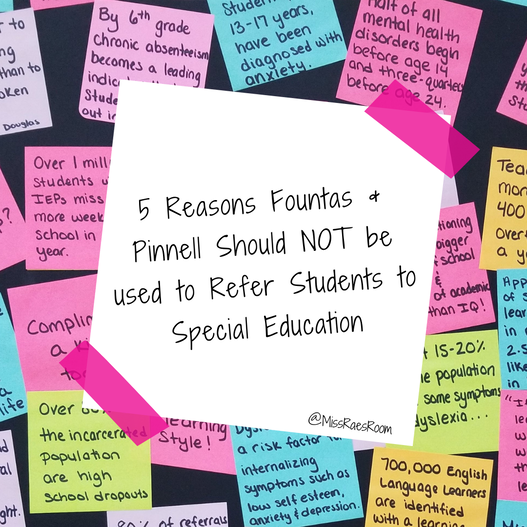|
7/4/2019 4 Comments 5 Reasons Fountas & Pinnell Should NOT be used to Refer Students to Special EducationThe Fountas & Pinnell Benchmark Assessment System has been popular literacy assessment over the years. This universal screener is administered individually, requiring about 20 – 40 minutes per student. The screener includes an oral reading component and a comprehension component. When taken together, these two components provide an instructional level for each student (independent, instructional, frustrational). The Fountas & Pinnell Benchmark Assessment System is similar to a running record, but… A Fountas & Pinnell reading level should NOT be the determining factor for a Special Education referral! F&P is Subjective! The Fountas & Pinnell Benchmark Assessment System is a subjective measure. This is because there is no right or wrong answer, and a teacher’s beliefs, assumptions, emotions, and opinions can influence the outcome of the score. Objective assessments have a single correct answer. Think true or false, multiple choice, and matching questions. Subjective tests include extended response questions and essays, or in other words, the Fountas & Pinnell Benchmark Assessment System. In addition, many of the benchmark tests include some inherent bias toward culture, background knowledge of the student, etc. In addition, at the start of the year, students can be hesitant to talk to a new teacher, while some students are shy all year! The open ended questioning format of the test can be biased against shy students, students lacking language, and others. The personality of a student can impact the outcome of the assessment. F&P is Only One Data Point As teachers, we know that one data point cannot be used to make an educational decision. Good teachers use numerous types of data from many sources to determine student strengths and areas to improve. How often does a student score one way on the Fountas & Pinnell Benchmark Assessment System, but is unable to read that same level of authentic text? Self-Correction Scores Do Not Impact F&P Reading Levels Self-correction is not taken into account when determining a student's reading level in the Fountas & Pinnell Benchmark Assessment System. Some students are able to achieve high accuracy and high comprehension scores, despite also demonstrating a high self-correction rate. Self-correction in reading is a good skill that teachers love to see. It shows us that students are visually attending to the text and self monitoring for meaning of the text. Typically, a high self-correction rate impacts comprehension, but for some students, it does not. This can mean that a student is reading “too fast” and not attending to the text for phonics (decoding) principles. This should indicate to a teacher that the student requires explicit instruction in attending to the text and may indicate a need for explicit instruction of phonics skills noted in the self-corrections on the running record. F&P is NOT Norm-Referenced The Fountas and Pinnell Benchmark Assessment is a criterion-referenced tests. Such tests are designed to determine if a student has a set of skills. A norm-referenced assessment compares the student’s performance to other same-aged students. Fountas & Pinnell Benchmark Assessment System touts itself as just that - a benchmark assessment! This means that it can be used to measure student progress against a grade level or learning goal. Benchmark assessments, like the F&P, are interim assessments and should be given in between formative and summative assessments. The F&P Benchmark Assessment is based on empirical research on language development, vocabulary expansion, reading acquisition, and reading difficulties. The assessment system has been field tested, but there is no empirical evidence on it. There are NO F&P Police The F&P Benchmark Assessment does have directions for administration; however, as teachers, we know that every student is different, and not every student follows the rules! What happens when a student makes an error on the same word repeatedly? Does this count as multiple errors or just one? What happens when the fluency rate is extremely low, but the accuracy and comprehension scores meet expectations? So who do we go to with our questions about the students who do not follow the F&P rules? Many schools have literacy coaches, but every coach seems to have their own interpretation and answers to our questions! For instance, I was once told that we stop assessing a student when he/she has achieved one year above grade level, even if we think this student could read at a higher level. Is this right? While scores may have F&P norms in place, who is enforcing them? Are they F&P’s rules? And doesn’t this just add to more subjectivity? Fountas & Pinnell Should NOT be used to Refer Students to Special Education Independent studies examining the usefulness of the Fountas and Pinnell Benchmark Assessment System as a universal screener are limited. Furthermore, in studies, using F&P to identify students as at-risk have resulted in moderate sensitivity, or unacceptable rates of identification (Burns, et al., 2015). Fountas and Pinnell reading levels are one descriptor of a student’s reading ability, but it should not be our sole indicator. Its purpose is to inform instruction for teachers, relay to teachers, students, and families which skills are important to master, and express a student’s progress towards those learning goals, not to determine Special Education eligibility. By Miss Rae References: Burns, M. K., Pulles, S. M., Maki, K. E., Kanive, R., Hodgson, J., Helman, L. A., Preast, J. L., (2015). Accuracy of student performance while reading leveled books rated at their instructional level by a reading inventory. Journal of School Psychology, 53, 437-445. Center on Response to Intervention: Screening Tools Chart (https://rti4success.org/resources/tools-charts/screening-tools-chart) Klingbeil, D. A., McComas, J. J., Burns, M. K., & Helman, L. (2015). Comparison of predictive validity and diagnostic accuracy of screening measures of reading skills. Psychology in the Schools, 52(5), 500-514. http://doi.org/10.1002/pits.21839 Parker, D. C., Zaslofsky, A. F., Burns, M. K., Kanive, R., Hodgson, J., Scholin, S. E., & Klingbeil, D. A, (2015). A brief report of the diagnostic accuracy of oral reading fluency and reading inventory levels for reading failure risk among second- and third-grade students. Reading & Writing Quarterly, 31, 56-67.
4 Comments
|
CategoriesAll Comprehension CoPlanning CoTeaching Directed Reading DIY Fluency Fountas & Pinnell Graphic Organizers Guided Reading Lesson Planning Multi-Tiered Systems Of Support Phonological Awareness RAN Read And Respond Reading Reading Assessments Reading Comprehension Response To Intervention RTI Science Of Reading Science Of Reading For Special Education Teachers Special Education Special Education Eligibility Special Education Lesson Planning Teaching Strategy Visualizing & Verbalizing Visual Texts Vocabulary Writing Writing In Response To Reading |


 RSS Feed
RSS Feed